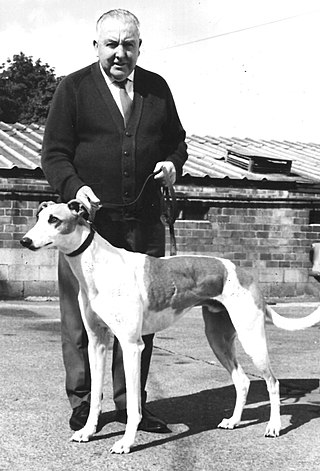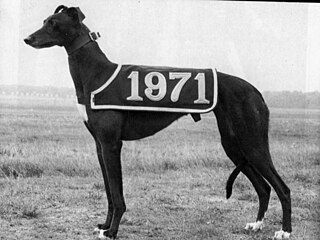| 1930 UK & Ireland Greyhound Racing Year | |
|---|---|
 Mick The Miller won the English Derby | |
The 1930 UK & Ireland Greyhound Racing Year was the fifth year of greyhound racing in the United Kingdom and Ireland.
| 1930 UK & Ireland Greyhound Racing Year | |
|---|---|
 Mick The Miller won the English Derby | |
The 1930 UK & Ireland Greyhound Racing Year was the fifth year of greyhound racing in the United Kingdom and Ireland.
Mick the Miller now trained by Sidney Orton successfully defended his English Greyhound Derby title and in the process propelled greyhound racing into a boom period that would last for over thirty years. [1] A crowd of 50,000 witnessed the brindle dog win the 1930 English Greyhound Derby at White City Stadium on 28 June. [2]
Following the Derby win, he then won the Cesarewitch at West Ham Stadium over the longer distance of 600 yards and the Welsh Greyhound Derby at White City Stadium, Cardiff, winning the final by ten lengths in a new track and national record of 29.55. [1] His season ended when he finished lame during the Laurels, a new event introduced at Wimbledon Stadium. [3] The total annual attendance across the country for 1930 increased to 17,119,120 from 15,855,162 (in 1929), a fourth consecutive annual increase. [4]
The Greyhound Racing Association (GRA) continued to acquire tracks and purchased White City Stadium (Manchester) from the Canine Sports Ltd company. The circuit was 450 yards in circumference with wide well banked turns and an inside Sumner hare. Further tracks continued to open including Charlton and the Irish tracks of Dundalk and Tralee. Romford moved to a new site after £600 was raised to build a stand in a nearby field next to the original site. The independent track (flapping track) in Portsmouth closed down on 29 November due to plans to open a larger track nearby at Target Road. [5] [6] [7]
Trainers Stanley Biss and Ken Appleton left Wimbledon for West Ham. John Bilsland bought out Jimmy Shand for £400,000 leaving the Electric Hare Company under the control of Bilsland. Blinkers were used at Wimbledon for the first and only time, the experiment to stop ungenuine greyhounds from fighting failed. [5] [6] [7]
Bradshaw Fold was the leading bitch in training and the unluckiest because following her second place to Mick the Miller in the Derby final, she was unplaced in a second consecutive Oaks final. [8] Fellow Derby finalist So Green also reached the St Leger final, the last major race of the year. [5] [6] [7] [9]
| Date | Stadium/Track | Location |
|---|---|---|
| 9 April | Kingdom Greyhound Stadium | Tralee |
| 15 May | Clydeholm | Glasgow |
| 20 July | Charlton Stadium | London |
| 2 September | Royal Gymnasium Ground | Edinburgh |
| 2 September | Nelson Recreation Ground | Glasgow |
| 29 October | Dundalk Ramparts Greyhound Stadium | Dundalk |
| 29 October | Firs Park | Falkirk |
| 13 December | County Ground Stadium | Exeter |
| unknown | Battersea Greyhound Track | London |
| unknown | Dagenham Greyhound Track | London |
| Major Winners | |
|---|---|
| Award | Name of Winner |
| 1930 English Greyhound Derby | Mick the Miller |
| 1930 Irish Greyhound Derby+ | Prince Fern |
| 1930 Scottish Greyhound Derby | Captured Half |
| 1930 Welsh Greyhound Derby | Mick the Miller |
+ unofficial National Derby
|
| ||||||||||||||||||||||||||||||||||||||||||||||||||||||||||||||||||||||||||||||||||||||||||||||||
|
+ Track record | ||||||||||||||||||||||||||||||||||||||||||||||||||||||||||||||||||||||||||||||||||||
|
| ||||||||||||||||||||||||||||||||||||||||||||||||||||||||||||||||||||||||||||||||||||
|
| |||||||||||||||||||||||||||||||||||||||||||||||||||||||||||||||||||||||||||||||||||||
|
| ||||||||||||||||||||||||||||||||||||||||||||||||||||||||||||
|
| ||||||||||||||||||||||||||||||||||||||||||||||||||||||||||||
U = unplaced

Wimbledon Stadium, also known as Wimbledon Greyhound Stadium, was a greyhound racing track located in Wimbledon in southwest London, England.
The 1928 UK & Ireland Greyhound Racing Year was the third year of greyhound racing in the United Kingdom and Ireland.
The 1929 UK & Ireland Greyhound Racing Year was the fourth year of greyhound racing in the United Kingdom and Ireland.
The 1931 UK & Ireland Greyhound Racing Year was the sixth year of greyhound racing in the United Kingdom and Ireland. The total annual attendance across the country for 1931 increased to 17,906,917 from 17,119,120, a fifth consecutive annual increase.
The 1932 UK & Ireland Greyhound Racing Year was the seventh year of greyhound racing in the United Kingdom and Ireland. The total annual attendance across the country for 1932 topped 20 Million, increasing to 20,178,260 from 17,906,917, a sixth consecutive annual increase.
The 1933 UK & Ireland Greyhound Racing Year was the eighth year of greyhound racing in the United Kingdom and Ireland.
The 1936 UK & Ireland Greyhound Racing Year was the 11th year of greyhound racing in the United Kingdom and Ireland.
The 1952 UK & Ireland Greyhound Racing Year was the 27th year of greyhound racing in the United Kingdom and Ireland.

The 1953 UK & Ireland Greyhound Racing Year was the 28th year of greyhound racing in the United Kingdom and Ireland.
The 1954 UK & Ireland Greyhound Racing Year was the 29th year of greyhound racing in the United Kingdom and Ireland.
The 1958 UK & Ireland Greyhound Racing Year was the 32nd year of greyhound racing in the United Kingdom and Ireland.

The 1960 UK & Ireland Greyhound Racing Year was the 34th year of greyhound racing in the United Kingdom and Ireland.
The 1964 UK & Ireland Greyhound Racing Year was the 38th year of greyhound racing in the United Kingdom and Ireland.
The 1967 UK & Ireland Greyhound Racing Year was the 41st year of greyhound racing in the United Kingdom and Ireland.
The 1969 UK & Ireland Greyhound Racing Year was the 43rd year of greyhound racing in the United Kingdom and Ireland.

The 1973 UK & Ireland Greyhound Racing Year was the 47th year of greyhound racing in the United Kingdom and Ireland.
The 1975 UK & Ireland Greyhound Racing Year was the 49th year of greyhound racing in the United Kingdom and Ireland.

The 1976 UK & Ireland Greyhound Racing Year was the 50th year of greyhound racing in the United Kingdom and Ireland.

Dolores Rocket was a famous racing greyhound during the 1970s. She is regarded as being one of the leading racing greyhounds in history and won the sports ultimate prize, the English Greyhound Derby.
James Stanley Biss known as Stan (1892–1952) was a leading English greyhound trainer. He was a seven times winner of the Oaks in addition to winning the Scottish Greyhound Derby and Welsh Greyhound Derby.